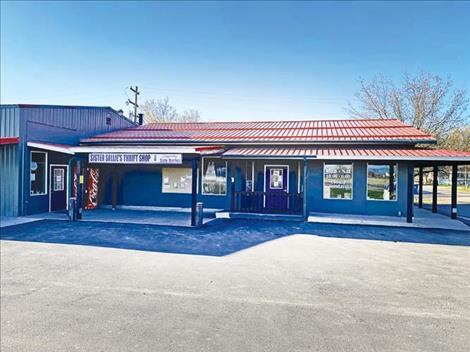Sister Sallie’s Store supports SAFE Harbor services, recycles
Hey savvy news reader! Thanks for choosing local.
You are now reading
3 of 3 free articles.
News from Dana Grant for Sister Sallie’s Thrift Store
RONAN — It started with a pile of clothes by the office door. Next, the stack included dishes. Other days, one might find a dishwasher or a couch or a sack of mismatched socks. The donations left at SAFE Harbor’s office for over eight years were sending a message.
“We would get these great donations for our clients. People were trying to help, but at times, the size of the donations completely filled the office,” said SAFE Harbor Executive Director DeeAnn Richardson. “But by 2019, we were able to move in a new direction.”
She is referring to the development and opening of Sister Sallie’s Thrift Store. Initially, the store was located on the edge of Ronan. Within a very short time, the staff recognized the need for a larger space.
“The response was impressive and we started looking for something that could sustain the donations,” Richardson explained. “Later that same year, we were able to relocate and expand our offerings.”
The new Sister Sallie’s Thrift is located on Round Butte Road in Ronan. It has a much bigger display area, and a large storage and prep room. With donations and grants, SAFE Harbor completed the purchase of the site in 2020 and added a paved parking lot. Today, the store has both employees and volunteers. It is also a training location for SAFE Harbor clients seeking practical job experience.
People’s giving was inspiring and did directly benefit clients. Annually, SAFE Harbor assists more than 700 primary victims of violence and an additional 400 secondary victims within Lake County and the Flathead Reservation.
Another consideration from the start has been how to insure the store leaves the smallest possible environmental imprint at the landfill. Over the past year, the store has come up with creative ways to meet this objective. A big part of the process has been reviewing and incorporating the ideas of recycling, reducing, reusing and re-purposing.
First, many items arrive in boxes. These have to be broken down and taken to the recycling containers. Next, the staff sorts all donations. Through this process, some items might be identified that are stained, have a rip, missing a zipper or have other problems for reselling. At times, these products are put in sale bins because some customers are able to re-purpose or reuse. Other items are simply too worn to resell.
All mechanical donations are tested to see if they still work. Dishes and household goods are examined for cracks, chips or other damage. This process is also done with books and records. Sorting at the store is an around the clock venture.
Another issue involves movement of product. Over time, some items will be on the shelves or racks for months. SAFE Harbor does have some storage areas to house a percent of seasonal clothes and other items; however, space is limited.
With challenge, comes solution. For these challenges, SAFE Harbor’s staff tossed out a wide net in seeking innovative ideas that would help to honor donors support of the program, provide assistance to victims of violence, and work to reduce the store’s impact on the environment. Through research and conversations, SAFE Harbor has partnered with other agencies to make sure that the majority of donated materials are being reused, recycled, restored or re-purposed in some capacity.
The other agencies have regular shoppers who have specific uses for certain fabrics that might not otherwise sell. Another group of buyers seeks objects that need to be fixed, which in many instances might end up going to the landfill. Within the region, there is another much smaller thrift store that also supports victims of violence. The location is isolated with a small population, and when items have been on the shelves for a long period of time, staff from that store do a pick up.
Along with these efforts, clothing that is not utilized by any of these sources is sent to another location for baling. The bales can hold up to 700 pounds. After enough bales are made, the baling sight works with a distribution center in Washington State. Even old shoes are sent along the way. At the distribution center, the merchandise is sorted again. Clothing or material that that does not meet their standard is turned into rags for use by non-profit agencies in the area, and the rest is sent to other sites for use with homeless populations and those in poverty.
Giving by the community, which was the foundation for the entire process, continues to be a big part of the Sister Sallie’s Store experience. Community members support the store with donations. The store is then able to give to clients and others in need. Even at the store, the spirit of sharing is present. It is not unusual for a customer to offer to cover a shortage of payment for others in line in front of them. Others anonymously take care of an entire shopping spree for single parents and their kids, grandkids or foster care families.
One frequent elderly customer has activated a gift card to be applied at the store’s discretion toward purchases for single parents who are in need of financial support. Another couple has furnished a single mother who is in college and raising four children with a new place of residence with housewares and furniture from the shop. The generosity of spirit is met with surprise and gratitude, often expressed with emotion by the recipient. It’s commonplace to hear customers pay for their transactions with “and keep the change.”
Sister Sallie’s Store is always looking for volunteers. To find out more, contact Dana Merwin at 406-207-2849. Thank you to those who donate, shop and support the store, making this venture a success story for so many.
















